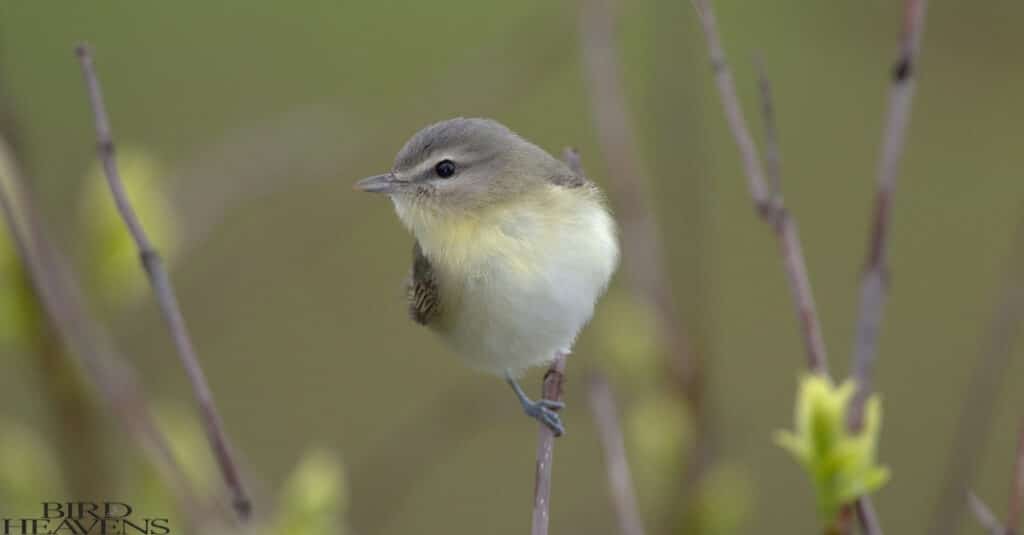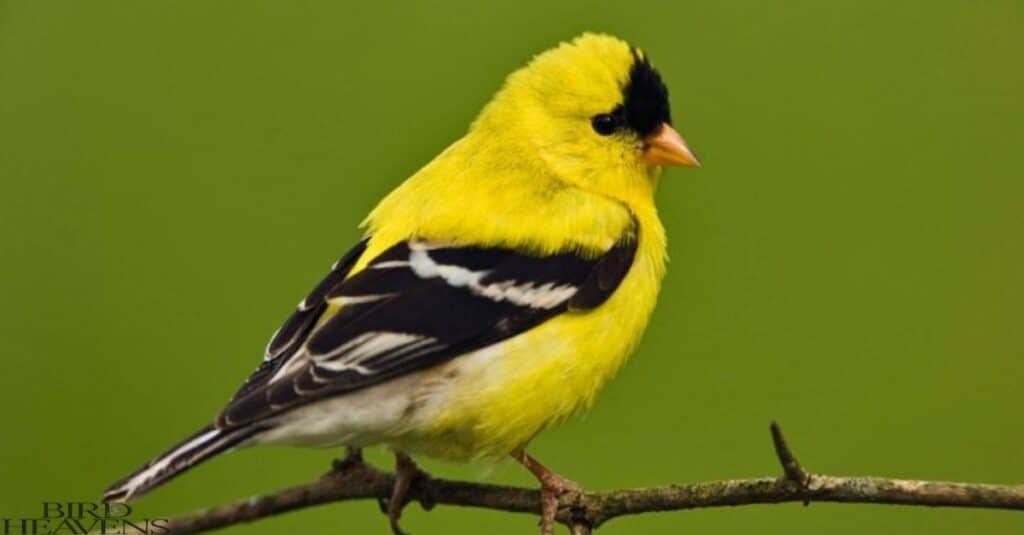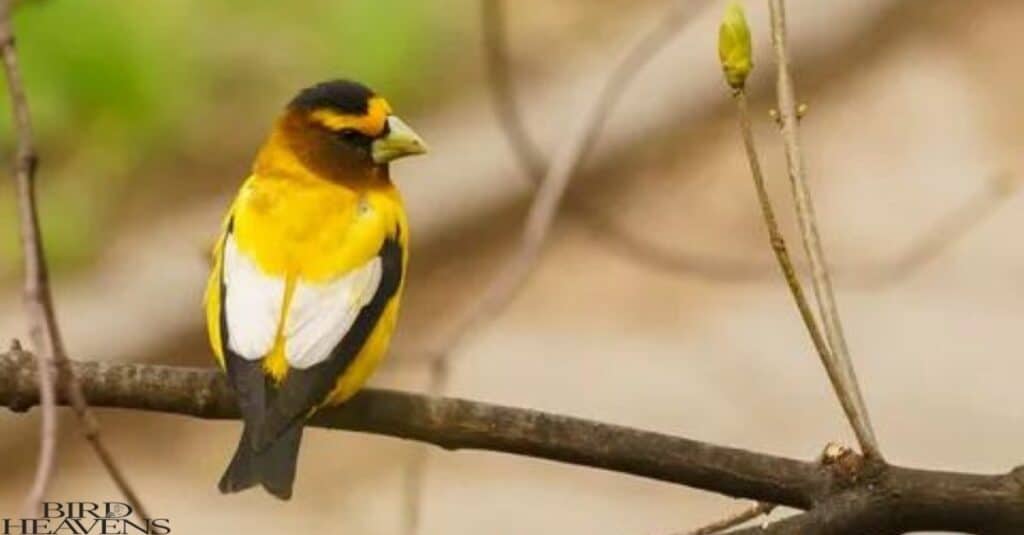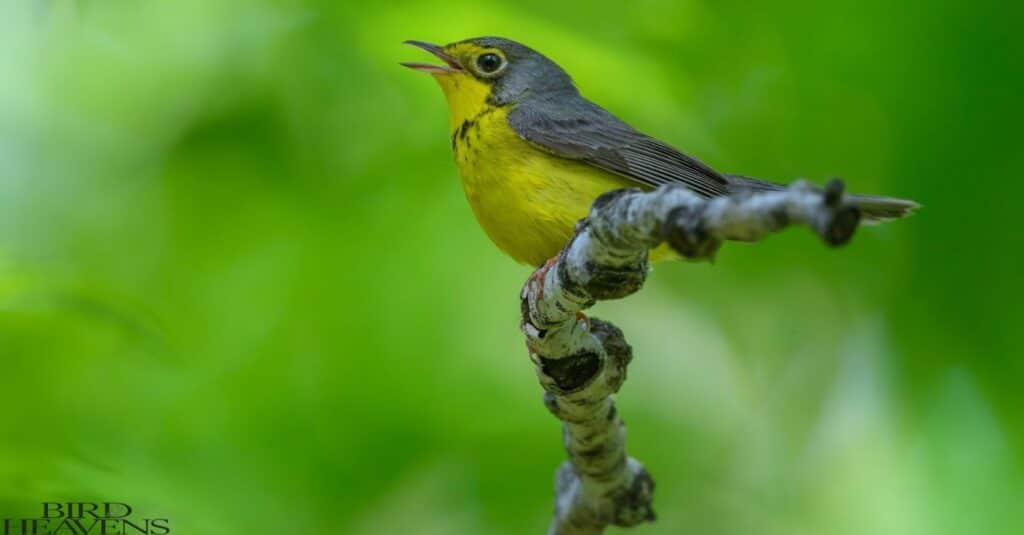29 Yellow Birds In Ohio With Photos
Ohio has many different types of birds, but yellow birds in ohio are some of the most beautiful. From the bright feathers of warblers to the golden color of finches, these birds bring a bit of sunshine to the skies and forests.
Whether you’re an experienced bird watcher or just curious about nature, this guide will help you find and enjoy Ohio’s yellow birds.We will provide you with an in-depth look at 29 species of yellow birds found in Ohio. Keep reading to identify the bird species you’ve seen!
Vireos:
Vireos might not be the first birds that come to mind when you think “yellow,” but these songsters often sport subtle yellow accents that add charm to Ohio’s woodlands.
Philadelphia Vireo:

The Philadelphia Vireo is small with olive-green upper parts and pale yellow wash on the throat and belly. Despite its name, it’s more likely to be spotted in Ohio during migration than in Philadelphia!
Migration and Their Special Traits:
- Migrates through Ohio in spring and fall, wintering in Central America
- Known for its rapid, chattering song and habit of foraging slowly through tree canopies
Best Spots for Sighting:
Look for them in deciduous and mixed forests, especially during spring and fall migrations.
Yellow-throated Vireo:

As its name suggests, the bright yellow throat and breast, olive-green back, white belly, and distinctive yellow spectacles.
Migration and Their Special Traits:
- Summer resident in Ohio, migrating to Central America and northern South America for winter
- Builds hanging cup nests decorated with lichens and spider silk
Best Spots for Sighting:
These birds prefer mature deciduous forests, often found high in the canopy.
Warbling Vireo:

The Warbling Vireo is a subtle beauty with pale grayish-olive upper parts with subtle yellow wash on flanks and undertail , rolling song is often heard before the bird is seen.
Migration and Their Special Traits:
- Long-distance migrant, arriving in Ohio in late April and departing by October
- Renowned for its continuous, melodious warbling song that can last for several minutes
Best Spots for Sighting:
Look for them in open woodlands, especially near water sources.
Finches:
Finches bring a dash of golden brilliance to Ohio’s bird feeders and fields. These seed-eaters are among the most recognizable yellow birds in the state.
American Goldfinch:

The American Goldfinch is Ohio’s state bird and a year-round resident. Males have bright yellow body with black cap, wings, and tail in breeding plumage, while females are olive-yellow year-round
Migration and Their Special Traits:
- Year-round resident in Ohio, with some northern populations moving south for winter
- Unique among finches for molting twice a year and delayed breeding season (July-September)
Best Spots for Sighting:
Common in gardens, fields, and at bird feeders stocked with nyjer seeds.
“The American Goldfinch is like a little piece of flying sunshine,” says Ohio birder Jane Doe. “Their cheerful calls and bright colors never fail to lift my spirits.”
Evening Grosbeak:

The Evening Grosbeak is a chunky finch with a large, pale bill. Males have yellow body with black wings, tail, and crown prominent white wing patches .While females are grayish-brown with yellow tinge and white wing patches
Migration and Their Special Traits:
- Irruptive winter visitor to Ohio, breeding in northern forests
- Known for their powerful beaks that can crack large seeds and even small nuts
Best Spots for Sighting:
These winter visitors are often found in coniferous forests and at feeders offering sunflower seeds.
Pine Siskin:

While not predominantly yellow, the Pine Siskin has yellow wing bars and tail edges that flash brightly in flight.
Migration and Their Special Traits:
- Irruptive winter visitor to Ohio, movements driven by seed crop availability
- Often seen hanging upside down on conifer cones while feeding
Best Spots for Sighting:
Look for them in coniferous forests and mixed woodlands, especially during winter irruptions.
You Might Like >>Finches in Ohio
Blackbirds and Orioles:
Ohio’s meadows and forests are home to several species of blackbirds and orioles that feature striking yellow plumage.
Eastern Meadowlark:

The Eastern Meadowlark is a ground-dwelling bird with bright yellow underparts with distinctive black “V” on chest, brown-streaked back
Migration and Their Special Traits:
- Partial migrant; some Ohio birds are year-round residents, others migrate south
- Known for its clear, whistling song often described as “spring-of-the-year”
Best Spots for Sighting:
Grasslands, pastures, and agricultural fields across Ohio.
Western Meadowlark:

Although less common in Ohio, the Western Meadowlark can occasionally be spotted in the western parts of the state.Similar to eastern meadowlark with yellow underparts and black “V”, slightly paler overall but has a slightly different song.
Migration and Their Special Traits:
- Rare visitor to western Ohio, more common in Great Plains
- Distinguishable from Eastern Meadowlark by its rich, flute-like song
Best Spots for Sighting:
Open grasslands and prairies in western Ohio.
You Might Like >>Why Do Crows Chase Hawks?
Yellow-headed Blackbird:

The Yellow-headed Blackbird is a rare but striking visitor to Ohio. Males have striking yellow head and breast contrasting with black body and white wing patches and females are Brownish with duller yellow head and breast
Migration and Their Special Traits:
- Rare migrant in Ohio, breeding in western marshes
- Produces a unique, harsh call often compared to a rusty gate opening
Best Spots for Sighting:
Marshes and wetlands, particularly during migration.
Baltimore Oriole:

The Baltimore Oriole is a summer resident in Ohio, known for its brilliant orange plumage.Males are brilliant orange body with black head, wings, and tail and females are yellowish-orange underparts with grayish-brown upper parts
Migration and Their Special Traits:
- Long-distance migrant, arriving in Ohio in late April and departing by September
- Skilled weavers, constructing intricate hanging nest pouches
Best Spots for Sighting:
Deciduous forests, parks, and suburban areas with mature trees.
You Might Like >>Birds With Funny Names
Warblers:
Ohio is a haven for warblers, many of which sport various shades of yellow. These small, active birds are a delight for birdwatchers, especially during spring and fall migrations.
Common Yellowthroat:

The Common Yellowthroat is easily recognized by its bright yellow throat and chest.Males are bright yellow throat and chest with distinctive black mask and females are olive-brown with pale yellow throat
Migration and Their Special Traits:
- Short-distance migrant, some Ohio birds overwinter in southern states
- Known for its “witchety-witchety-witchety” song and skulking behavior in dense vegetation
Best Spots for Sighting:
Wetlands, marshes, and brushy areas throughout Ohio.
Yellow Warbler:

True to its name, the Yellow Warbler is almost entirely yellow, Males are bright yellow all over with reddish streaks on chest .And females are slightly duller yellow without streaks
Migration and Their Special Traits:
- Long-distance migrant, wintering from southern Mexico to Peru
- Often adds a layer of plant material to its nest to cover cowbird eggs, a unique anti-parasite behavior
Best Spots for Sighting:
Willow thickets, stream edges, and young woodlands.
Yellow-rumped Warbler:

The Yellow-rumped Warbler is easily identified by its yellow rump patch.Grayish upper parts with distinctive yellow rump, sides, and crown in breeding males.
Migration and Their Special Traits:
- Partial migrant; some winter in southern Ohio while others travel to Central America
- Unique ability among warblers to digest the waxes found in bayberries, allowing them to winter farther north
Best Spots for Sighting:
Coniferous and mixed forests, particularly during migration.
You Might Like >>Do Owls Poop
Prothonotary Warbler:

The Prothonotary Warbler has a brilliant golden-yellow head and underparts with blue-gray wings and tail.
Migration and Their Special Traits:
- Long-distance migrant, wintering in mangrove swamps of Central and South America
- One of only two warblers that nest in tree cavities, often over water
Best Spots for Sighting:
Swamps and forested wetlands in southern Ohio.
Hooded Warbler:

The Hooded Warbler features a bright yellow face framed by a black “hood” in males.Females are similar but with incomplete or absent hood
Migration and Their Special Traits:
- Neotropical migrant, wintering in Central America and the Caribbean
- Known for its tail-fanning display, revealing white outer tail feathers
Best Spots for Sighting:
Understory of mature deciduous forests.
Kentucky Warbler:

The Kentucky Warbler has a bright yellow underside and a distinctive black “sideburn” pattern.
Migration and Their Special Traits:
- Long-distance migrant, wintering in Central America and northern South America
- Walks on the forest floor rather than hopping, unusual for a warbler
Best Spots for Sighting:
Dense understory of moist woodlands.
Wilson’s Warbler:

The Wilson’s Warbler is a small, bright yellow warbler with a distinctive black cap on males.
Migration and Their Special Traits:
- Long-distance migrant, traveling from Alaska to Central America
- Known for its constant tail-wagging behavior while foraging
Best Spots for Sighting:
Shrubby areas and forest edges during migration.
Canada Warbler:

The Canada Warbler has a yellow underside with a distinctive “necklace” of black streaks.
Migration and Their Special Traits:
- One of the latest spring migrants and earliest fall migrants in Ohio
- Builds its nest on or near the ground, often in moss-covered stumps
Best Spots for Sighting:
Cool, moist forests with dense understory.
Magnolia Warbler:

The Magnolia Warbler features a yellow underside with bold black streaking and white wing patches yellow rump
Migration and Their Special Traits:
- Migrates through Ohio to breeding grounds in northern forests
- Named for magnolia trees where it was first discovered, though rarely seen in them
Best Spots for Sighting:
Coniferous and mixed forests, especially during migration.
Palm Warbler:

The Palm Warbler has a brownish back with a yellow underside with rusty cap and streaked sides.
Migration and Their Special Traits:
- Early spring and late fall migrant in Ohio
- Unusual among warblers for its habit of walking on the ground and constantly wagging its tail
Best Spots for Sighting:
Open areas, fields, and forest edges during migration.
Pine Warbler:

The Pine Warbler has a yellow breast and throat with grayish-olive upperparts.
Migration and Their Special Traits:
- Partial migrant; some may overwinter in southern Ohio
- One of the earliest warblers to return in spring and latest to leave in fall
Best Spots for Sighting:
Pine forests and mixed woodlands.
Cerulean Warbler:

While primarily blue, the Cerulean Warbler males have azure blue upper parts with white underparts and dark breast band.Females have Blue-green upper parts with yellowish-white underparts.
Migration and Their Special Traits:
- Long-distance migrant, wintering in northern South America
- Nests higher in the canopy than most other warblers
Best Spots for Sighting:
Mature deciduous forests, particularly in eastern Ohio.
Prairie Warbler:

The Prairie Warbler has a bright yellow underside with distinctive black streaks on its sides.
Migration and Their Special Traits:
- Neotropical migrant, wintering in Florida and the Caribbean
- Known for its ascending, buzzy song and habit of bobbing its tail while foraging
Best Spots for Sighting:
Scrubby fields and young forest areas.
American Redstart:

The American Redstart males are black with bright orange patches on wings, tail, and sides. Females are gray with yellow patches.
Migration and Their Special Traits:
- Long-distance migrant, wintering from southern Florida to northern South America
- Uses its brightly colored tail and wing feathers to startle insects in a behavior called “flush-pursuit”
Best Spots for Sighting:
Deciduous and mixed forests across Ohio.
Golden-winged Warbler:

The Golden-winged Warbler has a gray body with distinctive yellow crown and wing patches; black throat and mask.
Migration and Their Special Traits:
- Long-distance migrant, wintering in Central and South America
- Declining species that sometimes hybridizes with Blue-winged Warblers
Best Spots for Sighting:
Shrubby areas and young forests, though increasingly rare in Ohio.
Chestnut-sided Warbler:

The Chestnut-sided Warbler has a bright yellow crown and greenish-yellow back.
Migration and Their Special Traits:
- Neotropical migrant, wintering in Central America
- Known for its cheerful “pleased-pleased-pleased-to-MEETCHA!” song
Best Spots for Sighting:
Brushy areas and forest edges.
You Might Like >>Are Penguins Friendly or Dangerous
Other Yellow Birds
These birds add their own splash of yellow to Ohio’s avian palette.
Dickcissel:

The Dickcissel is a sparrow-like bird in which males are yellow breast with black “V”, reminiscent of a small meadowlark.Females are Paler with streaked sides and faint yellow wash on breast.
Migration and Their Special Traits:
- Long-distance migrant, wintering in large flocks in Venezuela
- Known for its simple, persistent “dick-dick-cissel” song
Best Spots for Sighting:
Grasslands and agricultural areas in western Ohio.
Cedar Waxwing:

The Cedar Waxwing has a yellow-tipped tail and sometimes sports yellow wing tips.
Migration and Their Special Traits:
- Some individuals have orange-tipped tail feathers due to diet
- Resident in Ohio, with northern populations moving south in winter
- Often seen in large flocks, passing berries from bird to bird
Best Spots for Sighting:
Open woodlands, especially those with fruit-bearing trees.
Great Crested Flycatcher:

The Great Crested Flycatcher has a lemon-yellow belly that contrasts with its grayish-brown upperparts.
Migration and Their Special Traits:
- Neotropical migrant, wintering in southern Florida and Central America
- Known for incorporating snake skins into its nest, possibly to deter predators
Best Spots for Sighting:
Deciduous and mixed forests across Ohio.
Conservation Efforts:
While Ohio’s yellow birds bring joy to many, they face numerous challenges. Habitat loss, climate change, and pesticide use threaten many species. Here’s how we can help:
- Support local conservation initiatives: Organizations like the Ohio Bird Conservation Initiative work tirelessly to protect bird habitats.
- Create bird-friendly spaces: Plant native species in your garden to provide food and shelter for birds.
- Reduce pesticide use: Opt for natural pest control methods to protect the insects that many birds rely on for food.
- Participate in citizen science: Join projects like eBird to help track bird populations and movements.
- Advocate for bird-friendly policies: Support legislation that protects birds and their habitats.
| Conservation Action | Impact on Yellow Birds |
| Habitat Preservation | Protects nesting and feeding areas |
| Native Plant Gardens | Provides food sources and shelter |
| Pesticide Reduction | Increases insect prey availability |
| Window Collision Prevention | Reduces deaths from building strikes |
| Cat Control | Decreases predation on ground-feeding species |

Andrew Paul is a renowned ornithologist and founder of Bird Heavens. With my extensive expertise in bird behavior and habitat preservation,I will insightful content on species identification and conservation.My Future plans include interactive workshops and online courses to foster a global community of bird enthusiasts committed to conservation and appreciating avian life. Join me at Bird Heavens







